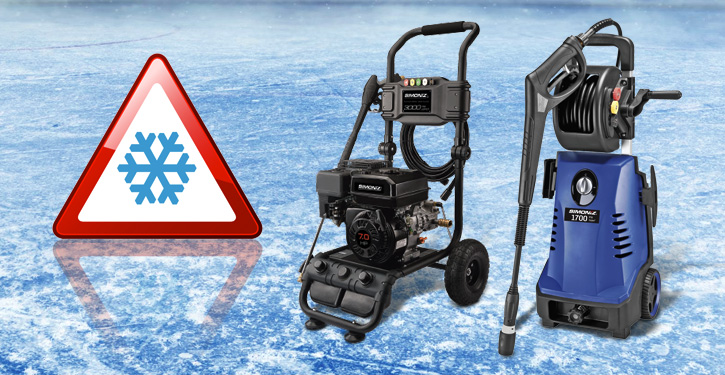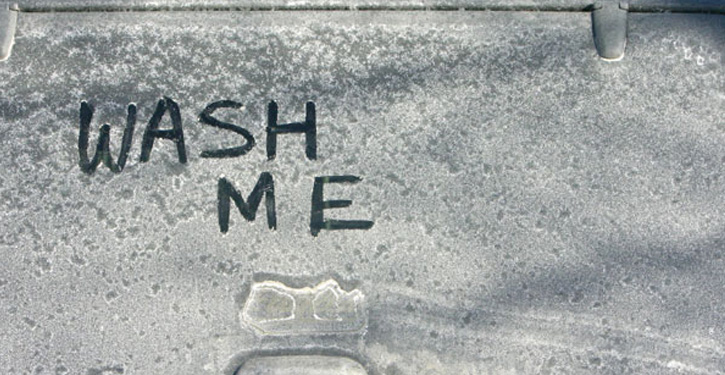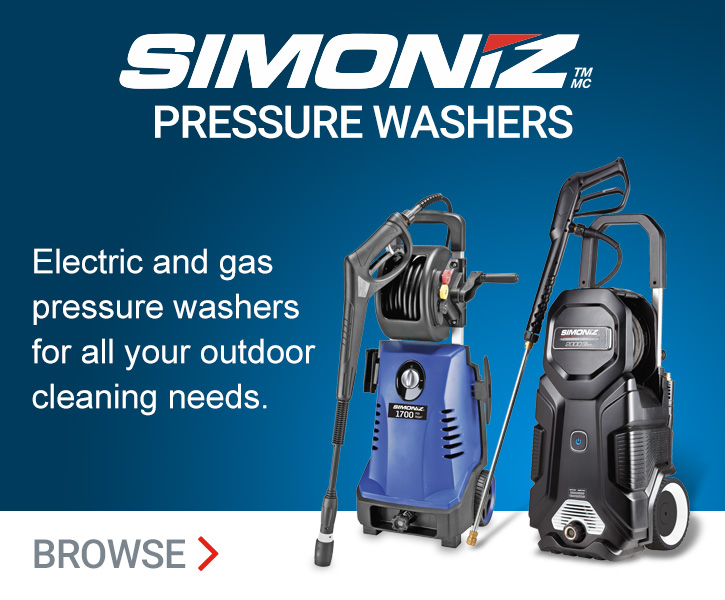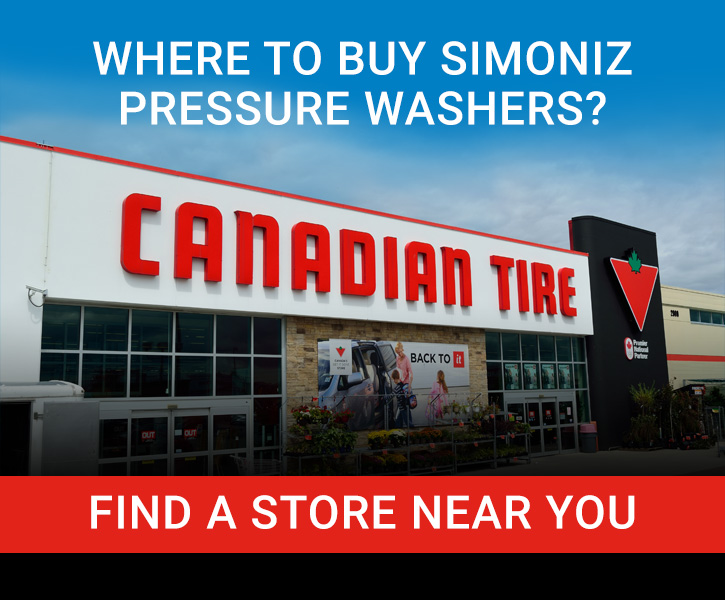GUIDE TO SELECTING THE RIGHT PRESSURE WASHER
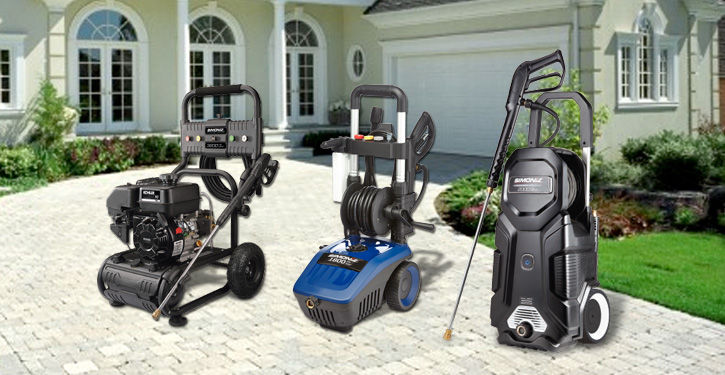
WHAT IS A PRESSURE WASHER AND HOW DOES IT WORK?
A pressure washer, also known as a power washer, is a motor driven device that propels water at high pressure to remove dirt, dust, grime, and stains from vehicles, siding, concrete and stone, wood fences and decks, windows, and much more around the house. Tough cleaning jobs that would take hours to perform manually with a garden hose, bucket and scrub brush, can be completed in a fraction of the time with the help of a pressure washer. Not only do pressure washers make quick work of these cleaning projects, they also reduce overall water consumption by as much as 80%.
ANATOMY OF A PRESSURE WASHER:
Regardless of which pressure washer you choose to purchase, you will find the basic layout and design to be quite similar from model to model. The key components of a pressure washer are as follows:
- AElectric Motor or Gas Engine — The power source for the high pressure pump. On electric models the motor is concealed inside the body of the pressure washer, while on a gas models the engine is readily visible.
- BWater Inlet — (electric or gas/diesel) Attaches to a garden hose and draws water into the pump from the faucet.
- CHigh Pressure Pump — Water is drawn into the high pressure pump where it is pressurized before being expelled through the water outlet.
- DHigh Pressure Hose — Specially designed and reinforced to safely transport the pressurized water to the spray gun.
- ESpray Gun/Wand — Designed with a trigger system, the spray gun enables the user and engage and disengage the high pressure water spray by squeezing or releasing the trigger in the gun handle.
- FWheels— Allows for the pressure washer to be easily rolled from location to location – no lifting.
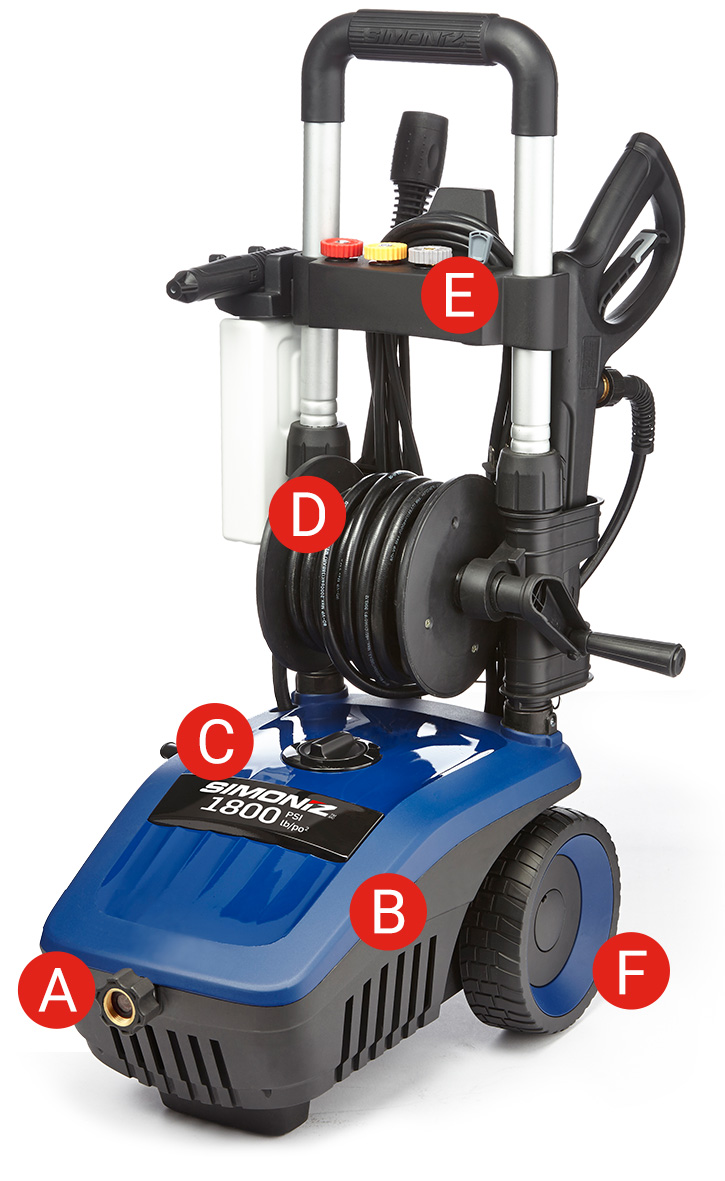
In addition to these key components, you will find that some units come with onboard detergent tanks or detergent applicators, spray tips that allow you to alter the spray pattern of the water, and other accessory attachments designed for specific cleaning projects such as automobiles, floor scrubbing, or window washing.
Important Pressure Washer Terms
When shopping for a pressure washer you may come across some unfamiliar terms. The following is a glossary of the most common terms and their definitions.
PSI: Pounds Per Square Inch, is a measure of the water pressure generated by the pump. The higher the PSI, the more pressure that is being generated.
GPM: Gallons Per Minute, refers to the volume of water that the pressure washer uses when the spray gun is engaged. Higher GPM typically means more effective cleaning.
CU: Cleaning Units, is calculated by multiplying PSI x GPM. The combined number is a good overall indicator of relative cleaning effectiveness, with higher being better.
CC: Cubic Centimeters, is a common measurement of gas engine size. The higher the CC, the larger the engine and the more power it will generate.
SELECTING THE RIGHT PRESSURE WASHER
Broadly speaking there are two types of pressure washers designed for residential use — electric and gas powered. Electric pressure washers are more compact and lighter in weight than their gasoline powered counterparts, and are ideal for small to medium sized residential cleaning projects. Electric pressure washers are also relatively maintenance free and don’t require oil changes or gas fill ups. In contrast, gas engine powered pressure washers deliver higher pressure than electric powered units making them ideal for medium to heavy-duty cleaning projects. Gas pressure washers are also great if you are working in areas where an electrical outlet is not available. The engine of a powered pressure washer, like other gas powered equipment, does however require regular maintenance to keep it in proper working order.

| ELECTRIC | GAS-ENGINE |
|---|---|
 Compact and lightweight Compact and lightweight |
 More powerful and durable More powerful and durable |
 Low maintenance – no need to add fuel or oil Low maintenance – no need to add fuel or oil |
 Ultimate portability – no need to locate power source or manage extension cords Ultimate portability – no need to locate power source or manage extension cords |
 Best for light to medium-sized cleaning projects Best for light to medium-sized cleaning projects |
 Wide range of cleaning projects requiring medium to heavy-duty power Wide range of cleaning projects requiring medium to heavy-duty power |
HOW MUCH PSI IS ENOUGH?
LIGHT-DUTY pressure washers in the 1,300 to 1,700 PSI range are great for cleaning patio furniture, lawn equipment, stairs, and vehicles such as automobiles and small SUV’s.
MEDIUM-DUTY pressure washers in the 1,800 to 2,000 PSI range can tackle bigger projects like large SUV’s, RV’s, siding and fencing, decks, garage floors and driveways.
HEAVY-DUTY pressure washers in the 2,100 PSI and above range deliver extra cleaning power and are great for large jobs such as long driveways, farm equipment, and paint stripping. Pressure washers in this PSI range are typically gas powered units.
| LIGHT 1300-1700 PSI | MEDIUM 1800-2000 PSI | HEAVY-DUTY 2100+ PSI | |
|---|---|---|---|
| Patio Furniture |  |
— | — |
| Vehicle |  |
 |
— |
| Lawn Equipment |  |
 |
— |
| Stairs |  |
 |
— |
| Siding | — |  |
 |
| Fencing | — |  |
 |
| Deck or Patio | — |  |
 |
| Second Story | — |  |
 |
| Garage Floor | — |  |
 |
| Driveway | — |  |
 |
| Farm Equipment | — | — |  |
| Paint Preparation | — | — |  |
OTHER FEATURES TO CONSIDER
Once you have decided on a electric or gas powered model and the PSI range that suits your needs, there are several other items to consider when selecting a pressure washer.
Adjustable Spray Patterns: The spray guns on most pressure washers offer variable spray patterns, but the range of patterns will vary from model to model. The most basic offering is an adjustable wand that allows you to switch between a narrow, high pressure pencil spray pattern and wider fan spray pattern. Interchangeable spray tips is another common offering. Typically, the spray tips come in sets of 3 to 5, offering a range of spray patterns for more precise control and different cleaning projects. A variant of the spray tips is a project dial, which offers many spray patterns in one handy attachment. To adjust the spray pattern simply turn the dial to the spray pattern that best suits the job.
PVC vs. Rubber Hoses: The hose on a pressure washer can come in a variety of lengths, diameters and materials. Most commonly, the hose is constructed of rubber or PVC. Rubber hoses tend to be more flexible and kink resistant than PVC, but both are suitable alternatives. As far as hose length goes, consider the types of projects you will be working on to determine if the hose length is sufficient.
Plastic vs. Metal Spray Guns: You will find that pressure washer spray guns are typically all plastic construction, or a combination of metal and plastic. Spray guns with metal components tend to more durable than their all plastic counterparts.
Onboard Accessory Storage: Though not essential, onboard accessory storage is a handy feature that allows you to keep all of the accessories including, the spray gun, wand, and spray tips in one, easily accessible location. No more hunting around for missing parts.
Hose Reel: Some pressure washer models come with a hose reel that enables you to easily wind and unwind of the high pressure hose without kinking or bending. This makes for easier and neater storage of the unit when not in use.
BENEFITS OF OWNING A PRESSURE WASHER
Regardless of what pressure washer you ultimately decide to purchase, the benefits owning one are obvious:
- 1Cleans FasterA pressure washer is simply faster and more effective at cleaning driveways, patios, decks, windows, and vehicles than traditional “bucket-and-brush” methods that you have used in the past. You’ll get the job done faster and it will look cleaner than if you had washed it by hand
- 2Professional ResultsYou'll get professional looking results at a fraction of the cost. Over time, the investment of owning a pressure washer definitely pays off.
- 3Water ConservationYou’ll use less water to get the job done. Pressure washers reduce water consumption by up to 80% versus a standard garden hose without an automatic shutoff nozzle, reducing gray water runoff.

